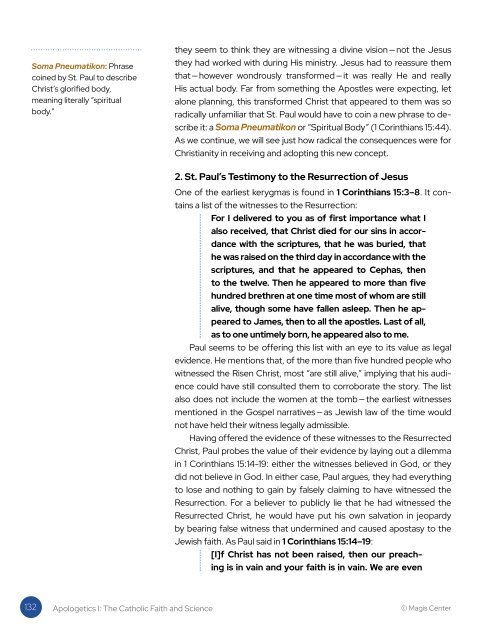CFS-WB-CH07
You also want an ePaper? Increase the reach of your titles
YUMPU automatically turns print PDFs into web optimized ePapers that Google loves.
Soma Pneumatikon: Phrase<br />
coined by St. Paul to describe<br />
Christ’s glorified body,<br />
meaning literally “spiritual<br />
body.”<br />
they seem to think they are witnessing a divine vision — not the Jesus<br />
they had worked with during His ministry. Jesus had to reassure them<br />
that — however wondrously transformed — it was really He and really<br />
His actual body. Far from something the Apostles were expecting, let<br />
alone planning, this transformed Christ that appeared to them was so<br />
radically unfamiliar that St. Paul would have to coin a new phrase to describe<br />
it: a Soma Pneumatikon or “Spiritual Body” (1 Corinthians 15:44).<br />
As we continue, we will see just how radical the consequences were for<br />
Christianity in receiving and adopting this new concept.<br />
2. St. Paul’s Testimony to the Resurrection of Jesus<br />
One of the earliest kerygmas is found in 1 Corinthians 15:3–8. It contains<br />
a list of the witnesses to the Resurrection:<br />
For I delivered to you as of first importance what I<br />
also received, that Christ died for our sins in accordance<br />
with the scriptures, that he was buried, that<br />
he was raised on the third day in accordance with the<br />
scriptures, and that he appeared to Cephas, then<br />
to the twelve. Then he appeared to more than five<br />
hundred brethren at one time most of whom are still<br />
alive, though some have fallen asleep. Then he appeared<br />
to James, then to all the apostles. Last of all,<br />
as to one untimely born, he appeared also to me.<br />
Paul seems to be offering this list with an eye to its value as legal<br />
evidence. He mentions that, of the more than five hundred people who<br />
witnessed the Risen Christ, most “are still alive,” implying that his audience<br />
could have still consulted them to corroborate the story. The list<br />
also does not include the women at the tomb — the earliest witnesses<br />
mentioned in the Gospel narratives — as Jewish law of the time would<br />
not have held their witness legally admissible.<br />
Having offered the evidence of these witnesses to the Resurrected<br />
Christ, Paul probes the value of their evidence by laying out a dilemma<br />
in 1 Corinthians 15:14-19: either the witnesses believed in God, or they<br />
did not believe in God. In either case, Paul argues, they had everything<br />
to lose and nothing to gain by falsely claiming to have witnessed the<br />
Resurrection. For a believer to publicly lie that he had witnessed the<br />
Resurrected Christ, he would have put his own salvation in jeopardy<br />
by bearing false witness that undermined and caused apostasy to the<br />
Jewish faith. As Paul said in 1 Corinthians 15:14–19:<br />
[I]f Christ has not been raised, then our preaching<br />
is in vain and your faith is in vain. We are even<br />
132 Apologetics I: The Catholic Faith and Science<br />
© Magis Center


